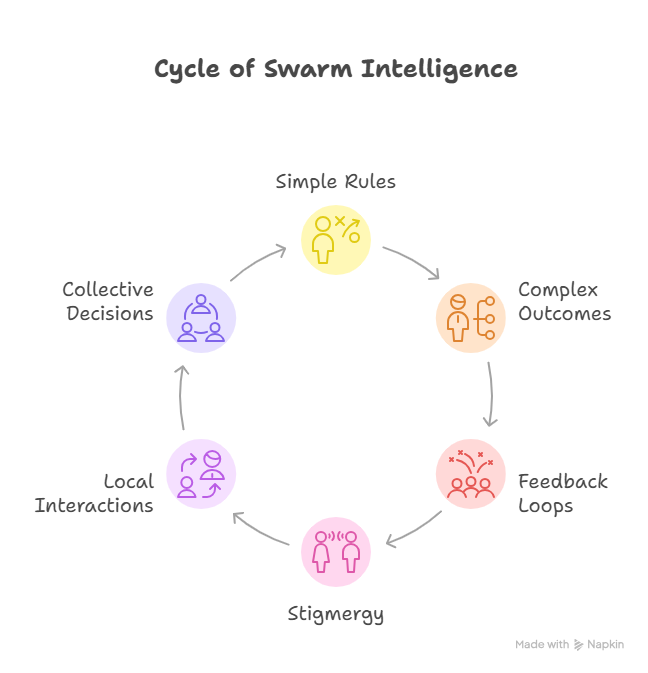If you observe an ant colony efficiently solving complex routing problems to find food you might be mesmerized by the patterns used. This natural phenomena share a remarkable characteristic: simple individuals following basic rules create sophisticated collective intelligence that no single member possesses. This is swarm intelligence: nature's time-tested approach to solving complex problems that scientists and engineers now harness to develop cutting-edge AI technology.
Understanding swarm intelligence opens doors to innovative solutions across robotics, optimization, logistics, and Artificial Intelligence (AI). This article explores what swarm intelligence truly means, how it works in nature, and how researchers apply these principles to create powerful AI solutions.
Swarm intelligence is the collective behavior of decentralized, self-organized systems, whether natural or artificial. To properly define swarm intelligence, we must recognize it as the emergent problem-solving capability that arises when simple agents interact locally with each other and their environment, producing intelligent global patterns without centralized control.
The term encompasses several key characteristics. First, swarm systems are fundamentally decentralized. No individual agent controls or directs the others. Second, they exhibit self-organization, meaning patterns and structures emerge spontaneously from local interactions. Third, they demonstrate emergent behavior, where the collective intelligence of the group far exceeds what any individual agent could achieve alone.
The core principle is elegantly simple: local interactions between agents following simple rules create sophisticated global solutions. For example, an individual ant cannot solve complex routing problems, but thousands of ants interacting through chemical signals collectively find optimal paths.
The formal study of swarm intelligence began in the late 1980s and early 1990s. Gerardo Beni and Jing Wang first coined the term "swarm intelligence" in 1989 while working on cellular robotic systems. Marco Dorigo developed Ant Colony Optimization algorithms in his 1992 doctoral dissertation, demonstrating how ant foraging behavior could solve computational problems. James Kennedy and Russell Eberhart introduced Particle Swarm Optimization in 1995, drawing inspiration from bird flocking and fish schooling behaviors.
To truly define swarm intelligence, we must understand its essential components:
Autonomous agents form the foundation, with individuals operating independently based on local information and simple behavioral rules. Local communication occurs as agents interact primarily with nearby peers rather than the entire group. Decentralized control distinguishes swarms from hierarchical systems because no single agent directs the activity. Emergent intelligence describes the way complex behaviors arise from simple individual actions, while self-organization explains how patterns form spontaneously without external guidance.

Swarm systems generate intelligent collective behavior through several core principles. The foundational insight is that simple rules can produce complex outcomes: each agent follows straightforward behavioral guidelines, yet sophisticated patterns emerge when many agents apply these rules simultaneously.
Positive and negative feedback loops regulate swarm behavior, with positive feedback amplifying beneficial actions such as ants reinforcing successful pheromone trails, and negative feedback, like pheromone evaporation, preventing overcommitment and maintaining flexibility. Stigmergy refers to indirect communication through environmental modifications; for example, termites coordinate construction by responding to mud deposits left by others, allowing the altered environment to guide subsequent behavior without direct interaction.
Information spreads through the swarm by local interactions, as one agent’s discovery changes its behavior and influences nearby agents, who then affect their neighbors in turn. These interactions aggregate into collective decisions.
Ants provide the most studied example of swarm intelligence in their foraging behavior. Individual ants wander somewhat randomly, depositing pheromone trails as they travel. Upon finding food, an ant returns to the nest, reinforcing its trail. Other ants detect these chemical signals and follow stronger trails.
Shorter paths accumulate pheromones faster because ants complete journeys more quickly. This positive feedback amplifies shorter routes while longer paths, receiving fewer reinforcements and losing pheromones to evaporation, gradually disappear. The colony collectively identifies optimal paths without any ant understanding the overall route network.
Honeybees exhibit sophisticated swarm intelligence during nest site selection. Scout bees evaluate potential locations and return to perform waggle dances: figure-eight patterns communicating direction and distance. Dance duration correlates with site quality; superior locations receive longer, more vigorous dances.
Other bees witnessing these dances may visit advertised sites themselves. If impressed, they return and perform their own recruitment dances. This creates positive feedback where better sites accumulate more scouts. Eventually, one site reaches a quorum threshold, and the swarm moves together toward the new home. Research shows swarms consistently choose the best available option through this democratic process.
Starling murmurations demonstrate swarm intelligence through three simple rules: maintain separation from nearest neighbors, align with nearby birds' velocity and direction, and move toward the average position of nearby birds. Each starling coordinates with approximately six or seven nearest neighbors, creating formations that respond almost instantaneously to threats.
Fish schools exhibit similar coordination with added hydrodynamic benefits. Schools reduce energy expenditure through drafting effects, create predator confusion, and make collective decisions about movement direction through implicit voting. When different group members prefer different directions, the school moves in a compromise direction weighted by the number supporting each option.
Bacterial colonies communicate through quorum sensing, releasing chemical signals whose concentration indicates population density. Termites construct elaborate mounds through simple rules about where to pick up and deposit soil pellets. Fireflies achieve synchronization by adjusting flash timing based on neighbors' flashes. Slime molds aggregate into multicellular forms and efficiently solve network optimization problems when connecting multiple food sources.
Engineers recognized that nature had evolved efficient solutions to optimization, routing, and resource allocation problems.
Natural swarm systems offer key advantages: inherent parallelism, robustness to individual failures, adaptability without reprogramming, and scalability. Computer scientists identify essential mechanisms underlying natural swarm behavior and create mathematical models capturing these dynamics, which become algorithms for solving computational problems.
Particle Swarm Optimization, introduced by Kennedy and Eberhart in 1995, simulates a swarm of particles moving through a solution space. Each particle represents a potential solution, with positions and velocities that update based on three components: momentum, cognitive influence (attraction toward personal best), and social influence (attraction toward the swarm's best).
This creates emergent intelligent search behavior. Early in the process, particles explore broadly. As good solutions are discovered, the swarm gradually concentrates around promising regions while maintaining exploration. PSO has proven effective for training neural networks, optimizing antenna designs, scheduling tasks, and solving engineering design problems.
Marco Dorigo's Ant Colony Optimization translates ant foraging into tools for combinatorial optimization. Artificial ants construct solutions by moving through graphs representing problems. At each step, ants probabilistically choose components based on artificial pheromone levels. Better solutions receive more pheromone deposits, while evaporation prevents premature convergence.
ACO has successfully tackled traveling salesman problems, vehicle routing, network routing, and scheduling. The algorithm excels when solution quality improves with increased computation time and when problem structure suits incremental construction.
The Artificial Bee Colony algorithm, developed by Derviş Karaboğa in 2005, models honeybee foraging with three bee types. Employed bees exploit specific solutions, onlooker bees select solutions to exploit based on quality, and scout bees explore randomly for new solutions. This division creates balanced search dynamics between exploitation and exploration.
Swarm robotics coordinates multiple robots for search and rescue operations, with hundreds of simple robots spreading through disaster zones more reliably than individual complex robots. Intel uses drone swarms for synchronized light shows. Amazon's warehouse robots navigate around each other without centralized traffic control, with each robot making local decisions while the system collectively optimizes package routing.
Traffic management systems use swarm principles for adaptive traffic lights that adjust timing based on local traffic density. UPS applies swarm-inspired algorithms to optimize delivery routes for thousands of drivers daily, saving millions of miles and gallons of fuel. Autonomous vehicle coordination allows vehicles to adjust speeds and routes collectively to optimize traffic flow system-wide.
Network routing protocols like AntNet use artificial ants to explore paths and deposit virtual pheromones, guiding data packets toward efficient routes. The system adapts automatically to network changes without manual reconfiguration. Load balancing across distributed servers employs swarm approaches to distribute requests efficiently.
Financial analysts apply Particle Swarm Optimization to portfolio optimization, selecting asset allocations that maximize returns while minimizing risk. Resource allocation problems—scheduling employees, assigning tasks, optimizing supply chains—benefit from swarm approaches. Data clustering in business intelligence uses swarm algorithms for customer segmentation and pattern identification.
Drug discovery uses swarm algorithms to explore molecular structure spaces, identifying promising candidates efficiently. Medical image analysis benefits from swarm-based optimization for image segmentation and feature extraction. Radiation therapy treatment planning uses swarm intelligence to optimize beam angles and intensities, maximizing tumor radiation while minimizing healthy tissue exposure.
Here are sssome advantages:
- Robustness and fault tolerance: No individual agent is critical, so the system continues functioning despite failures.
- Scalability: The same algorithms work from small to large populations, with performance often improving as agents are added.
- Flexibility and adaptability: Swarms adapt automatically to changing conditions without reprogramming.
- Simplicity of individual agents: Simple agents reduce costs and complexity while collective behavior provides sophisticated capabilities.
Swarm intelligence represents one of nature's most elegant problem-solving strategies and one of AI technology's most successful applications of biomimicry. To define swarm is to recognize sophisticated collective behavior emerging when simple agents interact locally, creating global intelligence exceeding individual capabilities.
From ant colonies to honeybees, from computational algorithms to real-world applications in robotics, logistics, and healthcare—swarm intelligence demonstrates the power of decentralized, emergent problem-solving. While not a universal solution, swarm approaches offer unique advantages for complex problems in dynamic environments, with their influence in AI technology continuing to expand as distributed computing and autonomous systems become increasingly prevalent.
